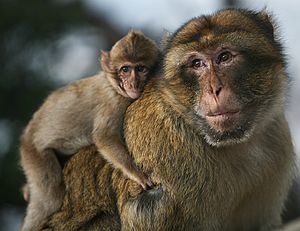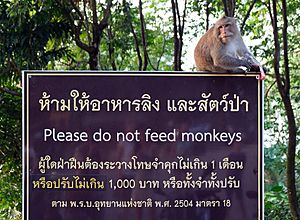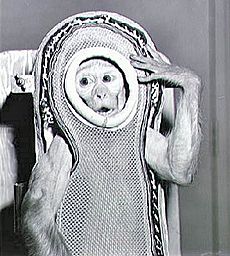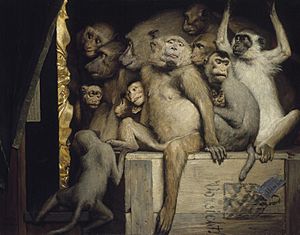Monkey facts for kids
Quick facts for kids Monkeys |
|
|---|---|
 |
|
| A Barbary macaque Macaca sylvanus |
|
| Scientific classification | |
| Kingdom: | |
| Phylum: | |
| Class: | |
| Order: | |
| Suborder: | |
| Infraorder: | |
| Groups | |
 |
|
| worldwide distribution of monkeys. | |
Monkeys are tree-dwelling (arboreal) mammals. They are in the primate order. Monkeys are intelligent, social animals. Most monkeys have a tail, even if it is a short one.
The word "monkey" is not a scientific term. It is used for two rather different groups of primates. The big distinction is between Old World monkeys and New World monkeys.
- Old World monkeys: Cercopithecidae. Apes are the descendants of Old World monkeys.
- New World Monkeys: Platyrrhini or Ceboidea (same thing in effect)
Both these groups are in the infraorder Simiiformes. That infraorder also includes the great apes and man.
Some monkeys live almost entirely in trees. Others live partly on the ground. Monkeys are mainly vegetarian, with a strong preference for fruit. However, they may eat a wide range of other food, including insects. Monkeys can live in forests and savannahs. Monkeys do not live in deserts. Some can live in snowy mountains, but more live in rainforests. There are none in the rainforests of Australia and New Guinea, and apparently they never reached those islands.
Some monkeys are small, about 15 centimetres (6 in) long and 120 grams (4.2 oz) in weight. Other monkeys are much larger, about 1 metre (3 ft 3 in) long and 35 kilograms (77 lb) in weight. A group of monkeys is called a "troop" of monkeys or a "tribe" of monkeys.
The two groups of monkeys live in different places: the New World Monkeys in South America and the Old World Monkeys live mainly in Africa and Asia. New World Monkeys are often smaller than Old World Monkeys. Monkeys have long arms and legs to help them swing from trees. Some monkeys' tails can wrap tightly around branches, almost like a "fifth limb". This type of tail is 'prehensile'.
The smallest known monkey is the pygmy marmoset. It is about 14-16cm in size (without the tail). It weighs about 120 grams. It lives in the treetops of rainforests in Brazil, Colombia and Ecuador. The largest known monkey is the mandrill. It can grow to about 1 m in size. Adults weigh up to 35 kg. The monkeys often climb with the help of their tails.
The word monkey might have come from a popular German story, "Roman de Renart" (Reynard the Fox). In there, the name of the son of Martin the Ape is Moneke.
In Africa, monkeys can be sold as "bushmeat" (meat of wild animals). Monkey brains are eaten in some parts of Africa, South Asia, and China.
Contents
Historical and modern terminology

According to the Online Etymology Dictionary, the word "monkey" may come from a German version of the Reynard the Fox fable, published circa 1580. In this version of the fable, a character named Moneke is the son of Martin the Ape. In English, no clear distinction was originally made between "ape" and "monkey"; thus the 1911 Encyclopædia Britannica entry for "ape" notes that it is either a synonym for "monkey" or is used to mean a tailless humanlike primate. Colloquially, the terms "monkey" and "ape" are widely used interchangeably. Also, a few monkey species have the word "ape" in their common name, such as the Barbary ape.
Later in the first half of the 20th century, the idea developed that there were trends in primate evolution and that the living members of the order could be arranged in a series, leading through "monkeys" and "apes" to humans. Monkeys were distinguished from "apes".
Description
Monkeys range in size from the pygmy marmoset, which can be as small as 117 mm (4+5⁄8 in) with a 172 mm (6+3⁄4 in) tail and just over 100 g (3+1⁄2 oz) in weight, to the male mandrill, almost 1 m (3 ft 3 in) long and weighing up to 36 kg (79 lb). Some are arboreal (living in trees) while others live on the savanna.
Diets differ among the various species but may contain any of the following: fruit, leaves, seeds, nuts, flowers, eggs and small animals (including insects and spiders).
Most New World monkeys have long tails, while Old World monkeys have non-prehensile tails or no visible tail at all. Although both the New and Old World monkeys, like the apes, have forward-facing eyes, the faces of Old World and New World monkeys look very different, though again, each group shares some features such as the types of noses, cheeks and rumps.
Classification
The following list shows where the various monkey families (bolded) are placed in the classification of living (extant) primates.
- Order Primates
- Suborder Strepsirrhini: lemurs, lorises, and galagos
- Suborder Haplorhini: tarsiers, monkeys, and apes
- Infraorder Tarsiiformes
- Family Tarsiidae: tarsiers
- Infraorder Simiiformes: simians
- Parvorder Platyrrhini: New World monkeys
- Family Callitrichidae: marmosets and tamarins (42 species)
- Family Cebidae: capuchins and squirrel monkeys (14 species)
- Family Aotidae: night monkeys (11 species)
- Family Pitheciidae: titis, sakis, and uakaris (41 species)
- Family Atelidae: howler, spider, and woolly monkeys (24 species)
- Parvorder Catarrhini
- Superfamily Cercopithecoidea
- Family Cercopithecidae: Old World monkeys (135 species)
- Superfamily Hominoidea: apes
- Family Hylobatidae: gibbons ("lesser apes") (20 species)
- Family Hominidae: great apes (including humans, gorillas, chimpanzees, and orangutans) (8 species)
- Superfamily Cercopithecoidea
- Parvorder Platyrrhini: New World monkeys
- Infraorder Tarsiiformes
Relationship with humans
The many species of monkey have varied relationships with humans. Some are kept as pets, others used as model organisms in laboratories or in space missions. They may be killed in monkey drives (when they threaten agriculture) or used as service animals for the disabled.
In some areas, some species of monkey are considered agricultural pests, and can cause extensive damage to commercial and subsistence crops. This can have important implications for the conservation of endangered species, which may be subject to persecution. In some instances farmers' perceptions of the damage may exceed the actual damage. Monkeys that have become habituated to human presence in tourist locations may also be considered pests, attacking tourists.
As service animals for disabled people
Some organizations train capuchin monkeys as service animals to assist quadriplegics and other people with severe spinal cord injuries or mobility impairments. After being socialized in a human home as infants, the monkeys undergo extensive training before being placed with disabled people. Around the house, the monkeys assist with daily tasks such as feeding, fetching, manipulating objects, and personal care.
Helper monkeys are usually trained in schools by private organizations, taking seven years to train, and are able to serve 25–30 years (two to three times longer than a guide dog).
In 2010, the U.S. federal government revised its definition of service animal under the Americans with Disabilities Act (ADA). Non-human primates are no longer recognized as service animals under the ADA. The American Veterinary Medical Association does not support the use of non-human primates as assistance animals because of animal welfare concerns, the potential for serious injury to people, and risks that primates may transfer dangerous diseases to humans.
In experiments
The most common monkey species found in animal research are the grivet, the rhesus macaque, and the crab-eating macaque, which are either wild-caught or purpose-bred. They are used primarily because of their relative ease of handling, their fast reproductive cycle (compared to apes) and their psychological and physical similarity to humans. Worldwide, it is thought that between 100,000 and 200,000 non-human primates are used in research each year, 64.7% of which are Old World monkeys, and 5.5% New World monkeys. This number makes a very small fraction of all animals used in research. Between 1994 and 2004 the United States has used an average of 54,000 non-human primates, while around 10,000 non-human primates were used in the European Union in 2002.
In space
A number of countries have used monkeys as part of their space exploration programmes, including the United States and France. The first monkey in space was Albert II, who flew in the US-launched V-2 rocket on June 14, 1949.
As food
Monkey brains are eaten as a delicacy in parts of South Asia, Africa and China. Monkeys are sometimes eaten in parts of Africa, where they can be sold as "bushmeat". In traditional Islamic dietary laws, the eating of monkeys is forbidden.
Literature

Sun Wukong (the "Monkey King"), a character who figures prominently in Chinese mythology, is the protagonist in the classic comic Chinese novel Journey to the West.
Monkeys are prevalent in numerous books, television programs, and movies. The television series Monkey and the literary characters Monsieur Eek and Curious George are all examples.
Informally, "monkey" may refer to apes, particularly chimpanzees, gibbons, and gorillas. Author Terry Pratchett alludes to this difference in usage in his Discworld novels, in which the Librarian of the Unseen University is an orangutan who gets very violent if referred to as a monkey. Another example is the use of Simians in Chinese poetry.
The winged monkeys are prominent characters in L. Frank Baum's Wizard of Oz books and in the 1939 film based on Baum's 1900 novel The Wonderful Wizard of Oz.
Religion and worship
Monkey is the symbol of fourth Tirthankara in Jainism, Abhinandananatha.
Hanuman, a prominent deity in Hinduism, is a human-like monkey god who is believed to bestow courage, strength and longevity to the person who thinks about him or Rama.
In Buddhism, the monkey is an early incarnation of Buddha but may also represent trickery and ugliness. The Chinese Buddhist "mind monkey" metaphor refers to the unsettled, restless state of human mind. Monkey is also one of the Three Senseless Creatures, symbolizing greed, with the tiger representing anger and the deer lovesickness.
The Sanzaru, or three wise monkeys, are revered in Japanese folklore; together they embody the proverbial principle to "see no evil, hear no evil, speak no evil".
The Moche people of ancient Peru worshipped nature. They placed emphasis on animals and often depicted monkeys in their art.
The Tzeltal people of Mexico worshipped monkeys as incarnations of their dead ancestors.
Zodiac
The Monkey (猴) is the ninth in the twelve-year cycle of animals which appear in the Chinese zodiac related to the Chinese calendar. The next time that the monkey will appear as the zodiac sign will be in the year 2028.
See also
 In Spanish: Mono para niños
In Spanish: Mono para niños






